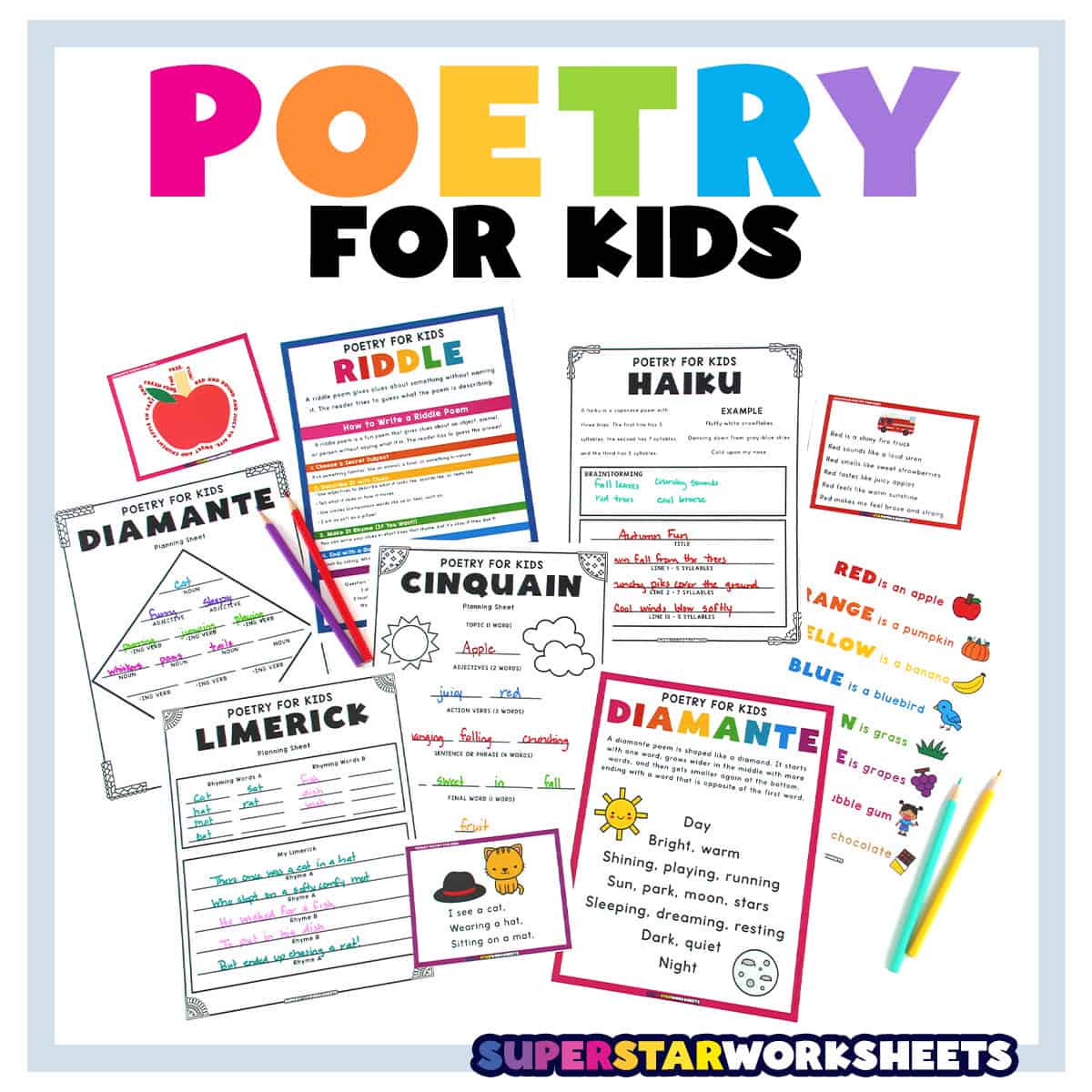
Poetry for Kids is filled with activities, charts, and example poems for 13 types of poems. Your elementary-aged students will enjoy making poetry books and writing fun poetry using our poetry for prompts for kids. Charts help students visualize different poems, while our templates help kids write poetry. Each poem below has the definition on a poster, example poems, and a template page. Simply download, print, and get started with poetry for kids!
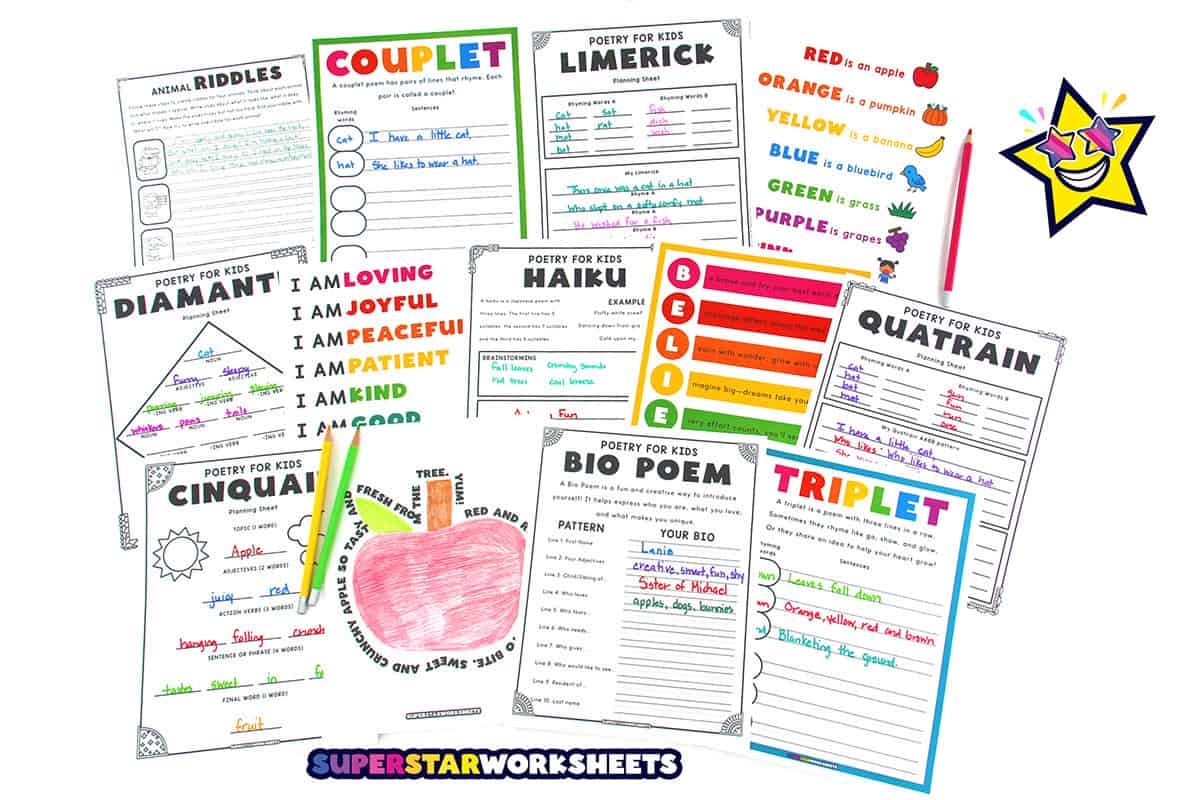
How to Write an Acrostic Poem for Kids
Free printable acrostic poem examples, writing templates, and anchor charts you can use to teach your children how to write acrostic poems. An acrostic poem is a creative writing form where the first letter of each line spells out a word, name, or phrase when read vertically. This word becomes the subject or theme of the poem. Each line typically describes or relates to the main subject. Download and print our acrostic poem guides, poetry examples, and templates below.
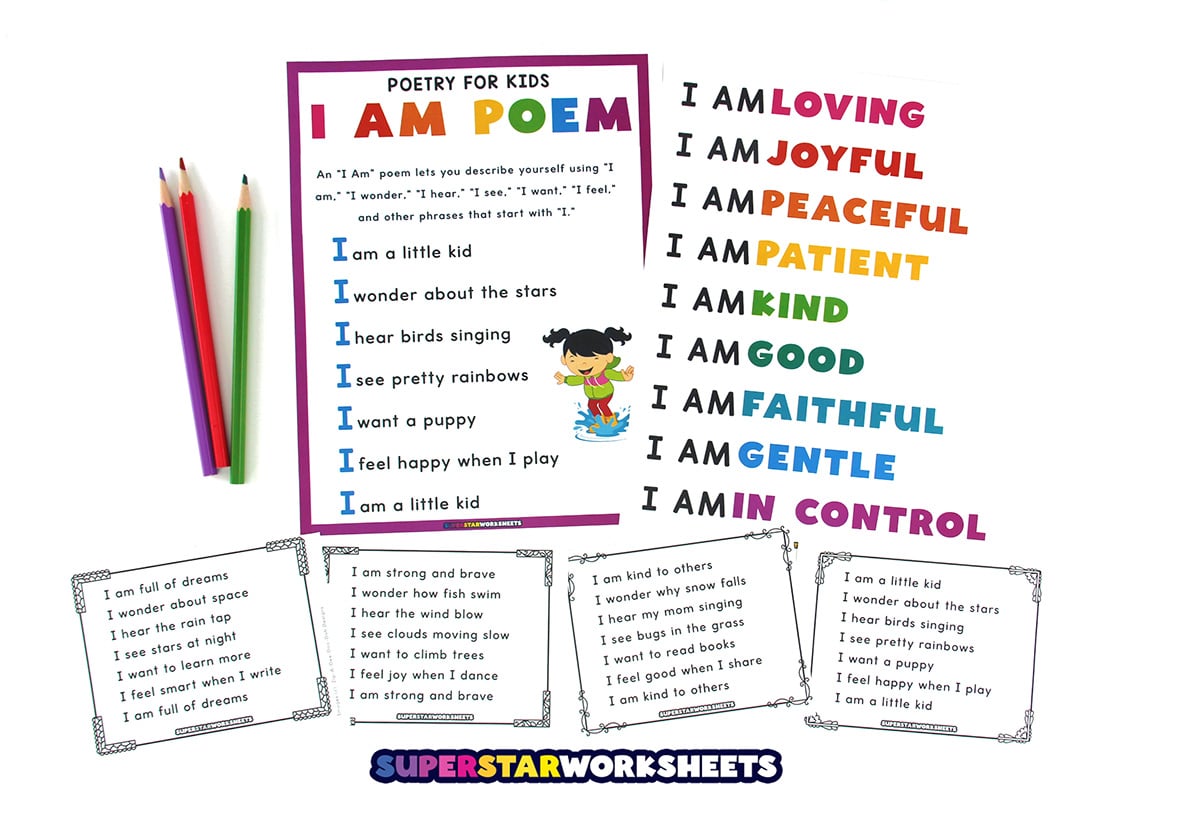
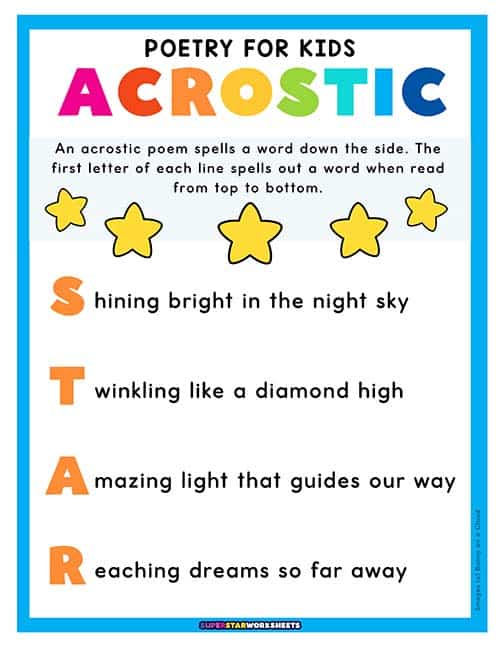
What is an Acrostic Poem
When teaching acrostics, show students how to brainstorm words that begin with each letter of their chosen topic word. Encourage them to use descriptive language rather than simple sentences. Try color-coding the first letter of each line to make the vertical word stand out. For younger students, provide letter prompts on the left margin as a guide. Challenge older students to create double acrostics where both the first and last letters of each line spell out words.
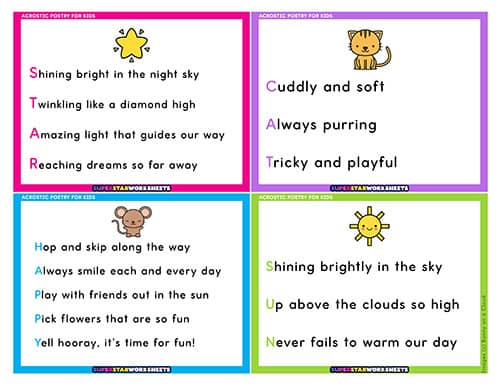
Acrostic Poetry for Kids
These exemplar acrostics about familiar topics like a “STAR” or a “CAT” to demonstrate the format. Note how quality acrostics utilize vivid adjectives and strong verbs, rather than basic sentences. Have students identify the theme word before reading the poem aloud. Extend the activity by having students illustrate their poems or create acrostics that connect to science or social studies units.
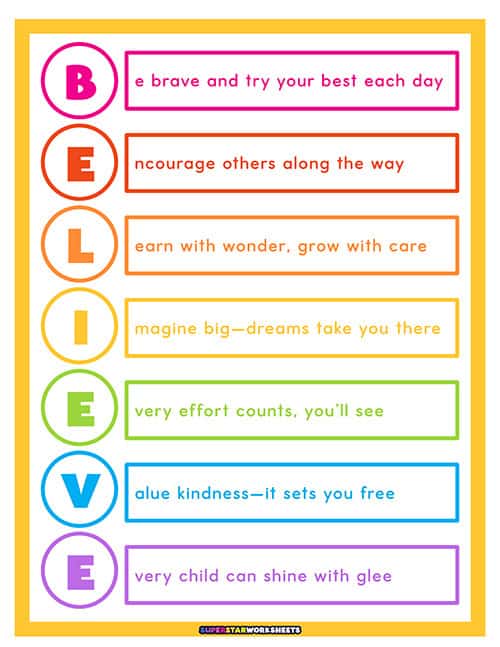
Acrostic Poem Example
This is an example of an acrostic poem. When students use acrostic templates, suggest they first brainstorm words related to their topic before attempting to match initial letters. Students can even create digital acrostics using online tools that allow them to adjust fonts and add images to enhance their poems.
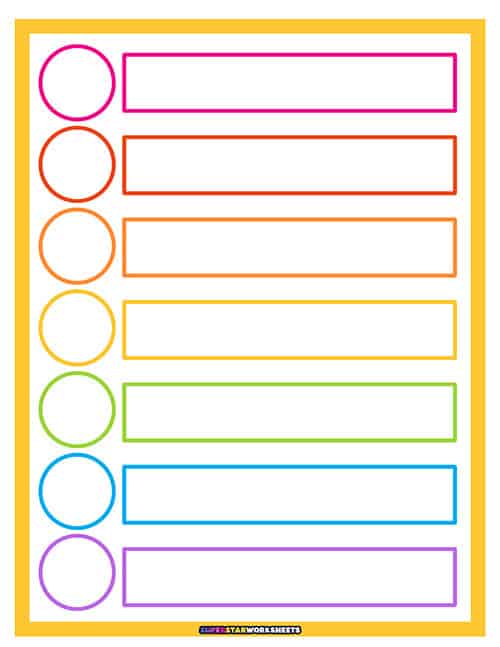
Acrostic Poem Template
This is a bright, rainbow PDF printable template that students can use to create an acrostic poem. Students can use their names, favorites, or meaningful words to create their acrostic poetry.
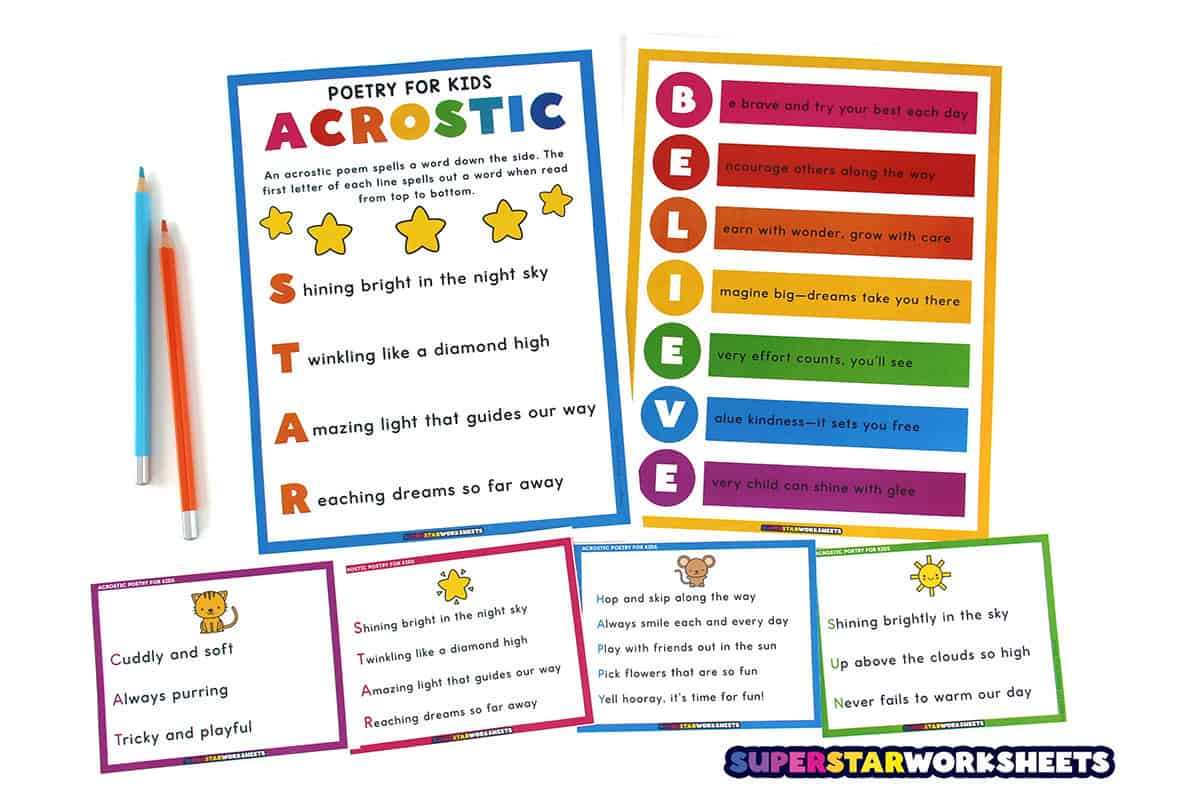
I Am Poem
Free printable “I Am” poem examples, writing templates, and anchor charts you can use to teach your children how to write “I Am” poems. An “I Am” poem is a personal expression poem that follows a repeating line pattern beginning with “I am…” statements. This type of poetry helps students explore and articulate their identities, feelings, beliefs, and experiences. “I Am” poems are excellent for developing self-awareness, building classroom community, and practicing descriptive language. For more activities/lessons for each type of poem, check out our How to Write Poetry resource today!
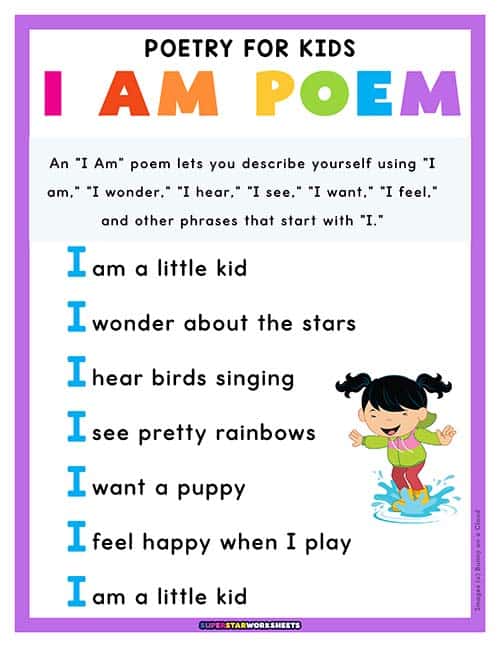
What is an I am Poem
This I Am poem anchor chart shows the repeating line starters with example responses. Begin with a class discussion about identity, asking students to consider what makes them unique. For younger students, focus on concrete aspects of identity (interests, family, abilities); for older students, encourage exploration of more abstract elements (values, dreams, fears).
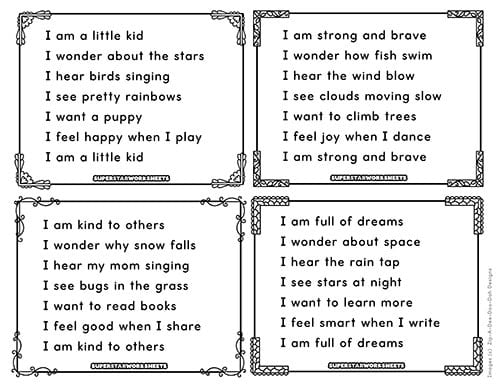
I Am Poetry for Kids
Our examples of I Am poems point out how effective poems include specific details rather than generalizations. Have students highlight lines that reveal something surprising or particularly meaningful about the writer. Take this poem to the next level by allowing students to create “We Are” poems in small groups to explore collective identities.
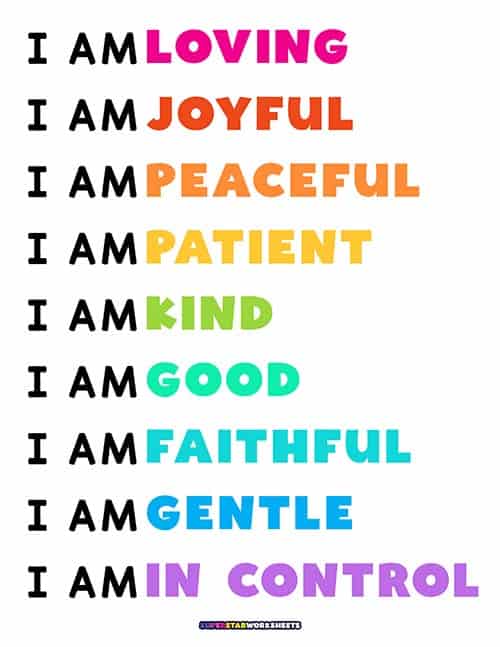
I Am Poem
An I am poem template provides sentence frames with the repeating starters, leaving ample space for student responses. For personal connection, suggest students include family traditions, favorite memories, hopes for the future, or unique talents. Display completed poems along with photos or self-portraits. Students can revisit and revise their “I Am” poems throughout the year, creating “beginning,” “middle,” and “end-of-year” versions to track their personal growth.
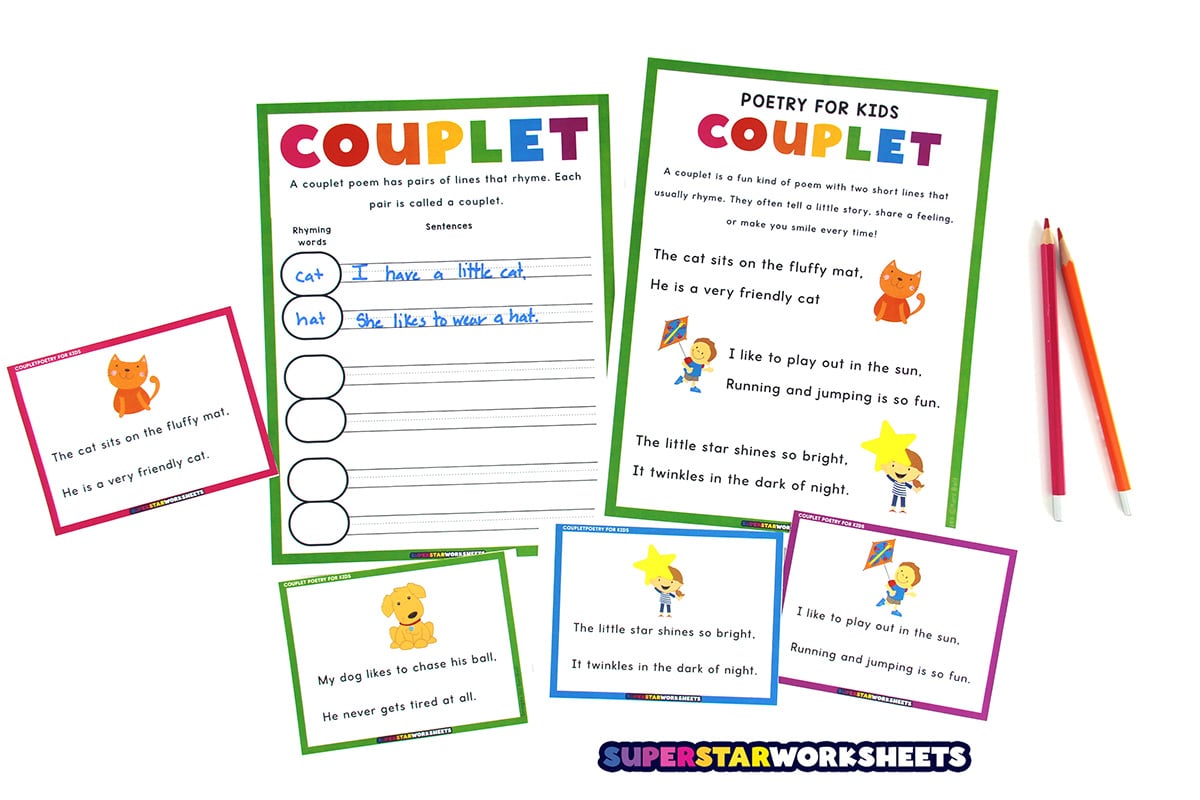
Couplet Poem
A couplet is one of the most accessible poetry forms for young writers, consisting of two lines that rhyme with each other and typically express a complete thought. Below you’ll find free printable couplet poem examples, writing templates, and anchor charts that you can use to teach your students all about couplet poems. Couplets help students develop phonological awareness as they search for rhyming words, and the brevity of the form encourages precision in word choice.
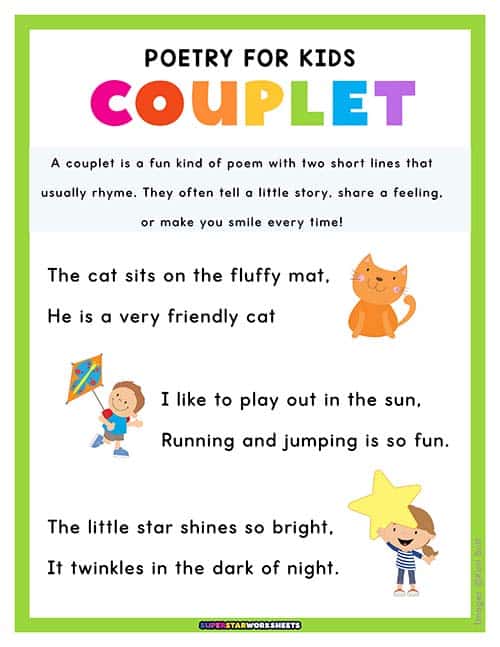
What is a Couplet Poem
A fun way to teach couplets is by creating a rhyming word wall that grows throughout the year. Model the couplet-writing process by thinking aloud as you craft a pair of rhyming lines about a familiar topic. For beginning writers, provide sentence stems that students complete with rhyming words: “I see a cat, / It’s wearing a __.” Challenge advanced students to maintain consistent syllable counts in their lines or to create couplets with internal rhyme in addition to end rhyme.
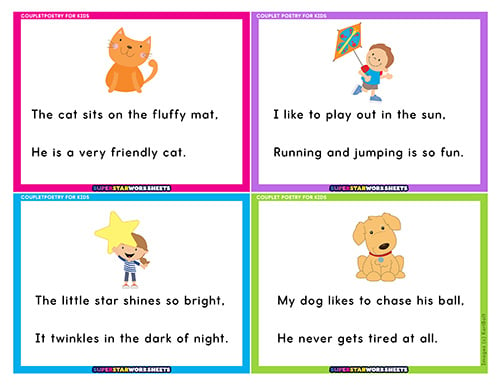
Couplet Poetry for Kids
Share couplets from nursery rhymes and children’s literature (Dr. Seuss is a great option!), pointing out how the rhymes enhance memorability. Have students identify the rhyming words and discuss how they contribute to the overall meaning.
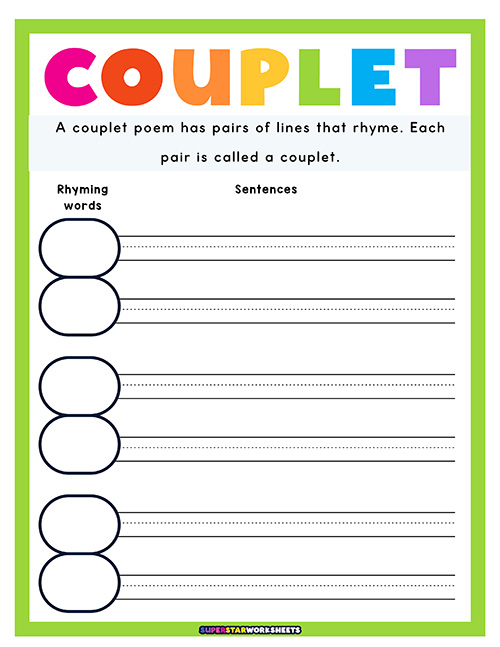
Couplet Poem Template
Students will use this template to list rhyming words and then create sentences. Each set of sentences will rhyme. Provide students with rhyming dictionaries or digital rhyming tools for students who struggle with finding rhymes. Display your students’ complete couplets in couplet books where each page contains an illustrated couplet created by a student in your classroom.
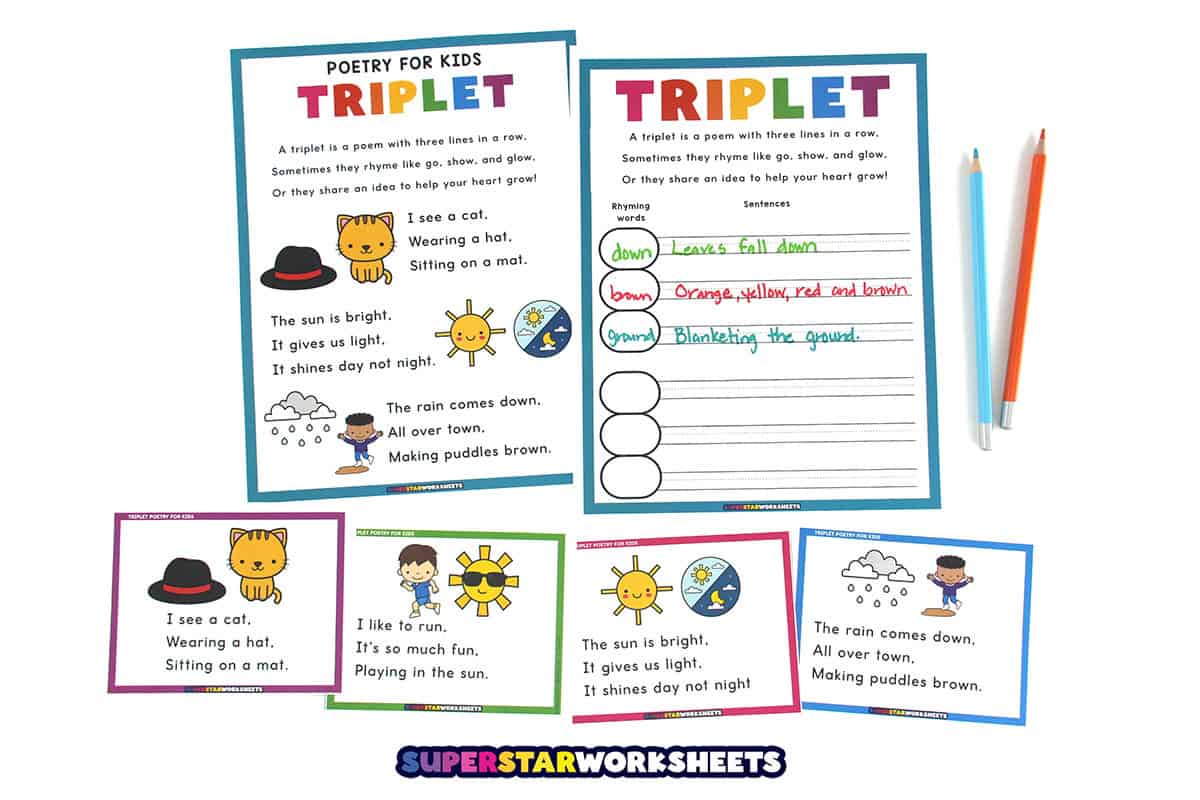
Triplet Poem
A triplet (also called a tercet) is a three-line stanza that can either stand alone as a complete poem or be combined with additional triplets to create a longer work. The most common form of triplet features three lines that all rhyme with each other. Triplets help students practice creating cohesive thoughts within constraints and develop phonological awareness through rhyming. Download and print our triplet poem guides, poetry examples, and templates below.
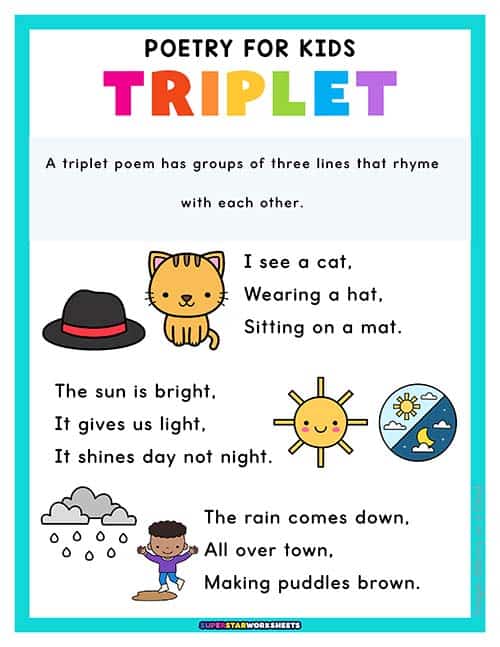
What is a Triplet Poem
This poster creates a visual showing the AAA rhyme pattern. Model how to brainstorm rhyming word sets by creating class lists of words that share end sounds. Focus on the three-line structure and introduce variations like ABA patterns.
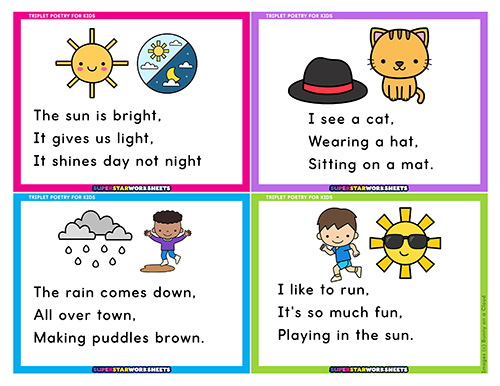
Triplet Poetry for Kids
There are four triplet examples on this printable PDF page. These poems for kids help students to identify rhyme patterns and discuss how the three-line structure shapes the message. Point out how effective triplets often use the third line to deliver a surprising twist or satisfying conclusion.
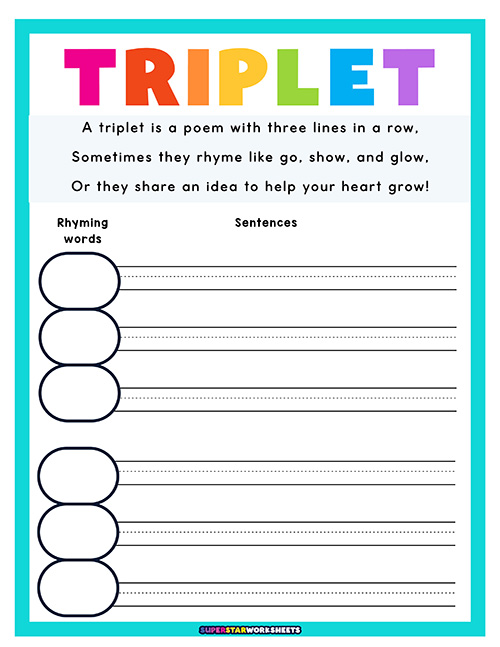
Triplet Poem Template
This triplet template has students write groups of (3) rhyming words, then create the sentence that it will be used with. Once created, display completed triplets on a bulletin board or wall. As a performance opportunity, students could each memorize and recite one line of a collaboratively written triplet.
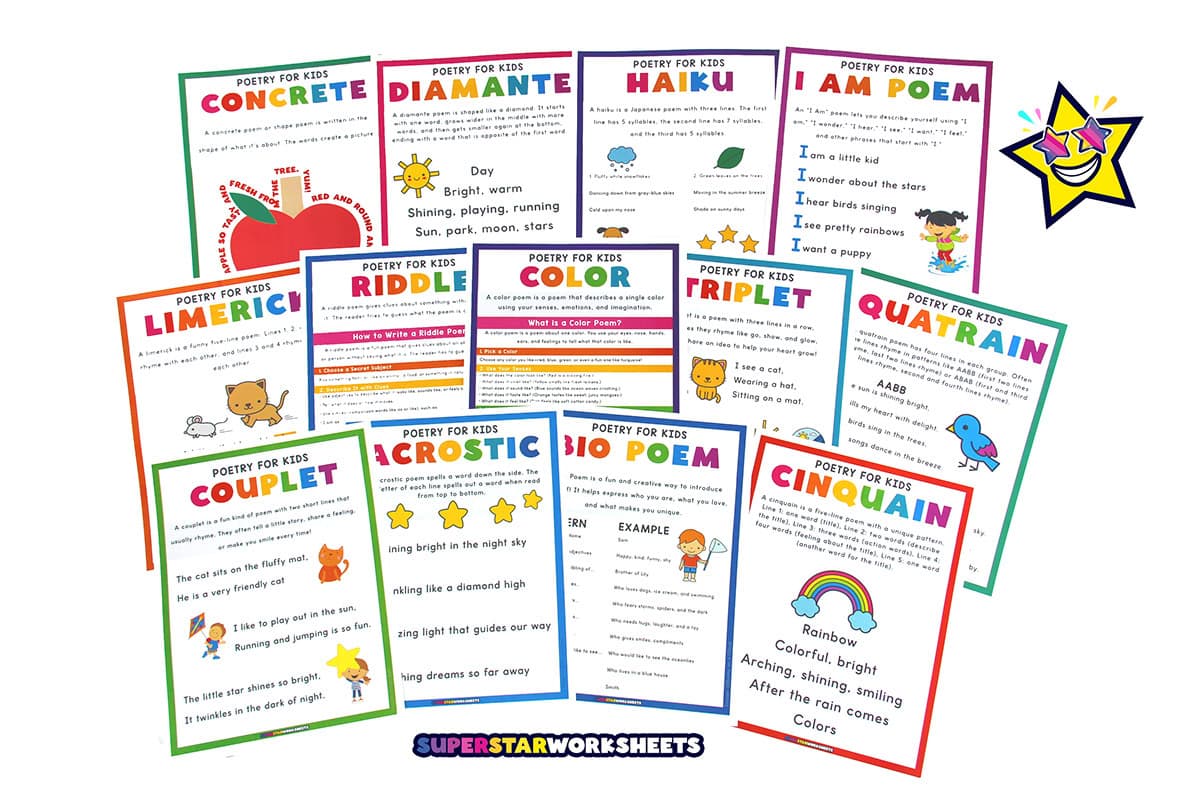
Concrete Poem – Shape Poetry
Free printable concrete (shape) poem examples, writing templates, and anchor charts you can use when teaching students how to write concrete poems. A concrete poem, also called a shape poem, is a creative form where the text is arranged to create a visual image that represents the poem’s subject. Unlike most poetry forms that focus primarily on language, concrete poetry merges visual arts with poetic expression—the physical arrangement of words on the page is as important as their meaning.
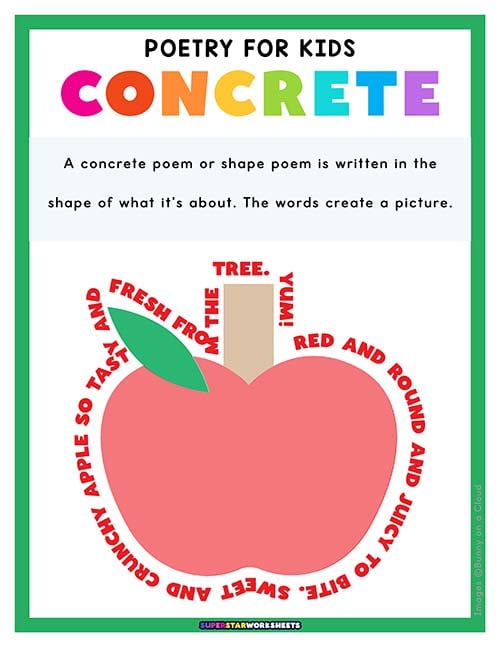
What is a Concrete/Shape Poem
When teaching concrete poetry, show students how the shape enhances the meaning of the words. This chart shows how the apple shape brings out the words. Have students sketch their shapes lightly in pencil before adding text, and encourage them to consider how word placement contributes to the overall effect. Don’t forget to show students how to manipulate text size, direction, and spacing to fill the shape effectively, emphasizing that not every line needs to be a complete sentence.
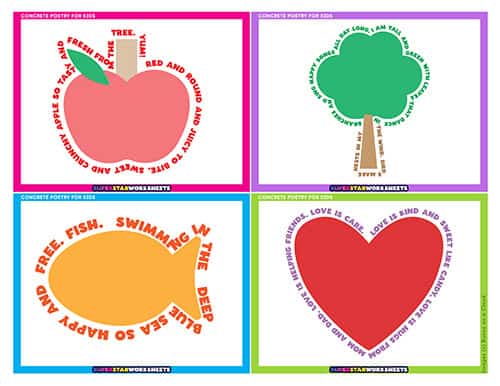
Concrete Poetry Examples
Share these fun examples of concrete poems shaped like their subjects—an apple-shaped poem about apples, a tree-shaped poem about trees, a goldfish-shaped poem about goldfish, and a heart-shaped poem about love. Have students identify specific words or phrases that enhance both the meaning and the visual effect. Point out how effective concrete poems use words that relate to the shape, not just random text.
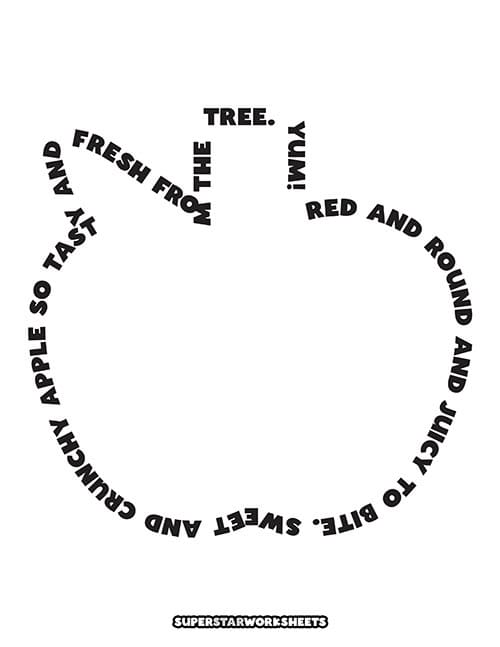
Concrete Poem Template
This template shows students an apple. We suggest giving students outline shapes that interest them to get started. For younger students, offer word banks that they can use to complete their shape poem. Encourage students to brainstorm topic-specific vocabulary before beginning to write. Students can even create shape poem collections for specific units of study as an end of unit assessment.
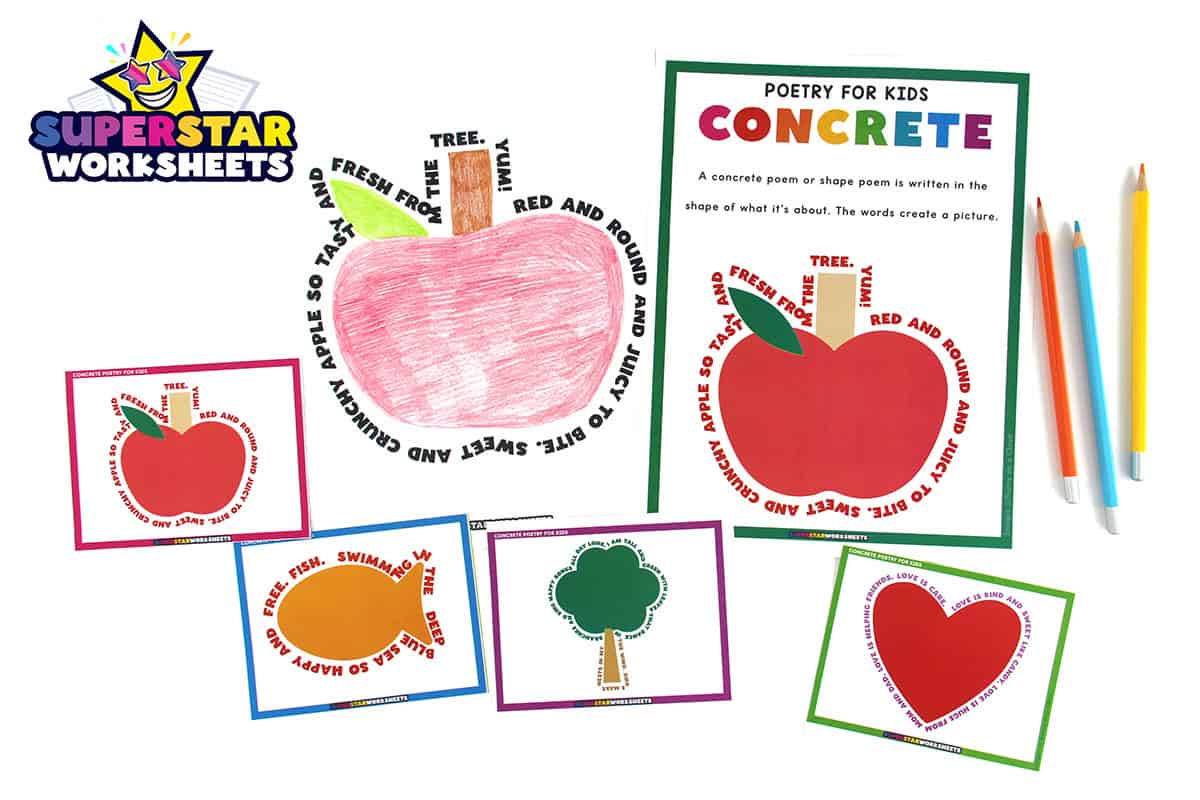
Bio Poem
Bio poems are structured poems that reveal characteristics about a person or character through a formulaic template, typically beginning with the subject’s name and ending with a feeling, wish, or trait. Bio poetry helps students reflect on identity—either their own or that of a character or historical figure they’re studying. Bio poems follow a specific pattern where each line addresses different aspects of the subject, such as traits, relationships, fears, accomplishments, and hopes. They’re excellent for character analysis in literature, historical figure studies, or personal reflection activities. Download and print various bio poem guides, poetry examples, and templates below.
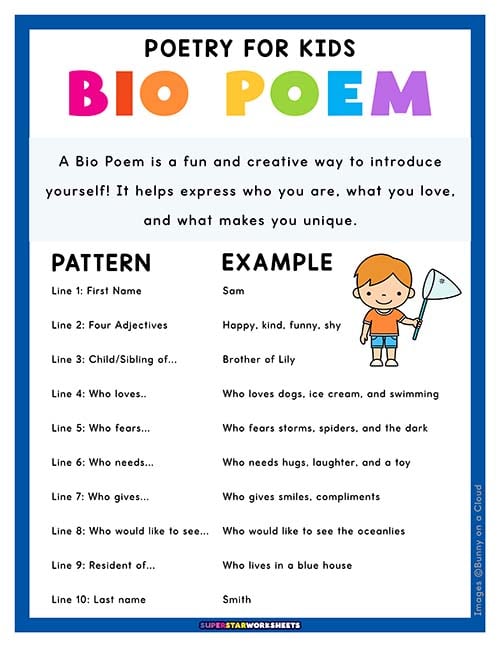
What is a Bio Poem for Kids
Our free Bio Poem poster contains the definition, the pattern as a template to follow, and an example poem. This class chart shows the required elements for each line with example words and phrases students might use. For differentiation, provide word banks for students who need vocabulary support or allow advanced students to modify the template to include additional elements.
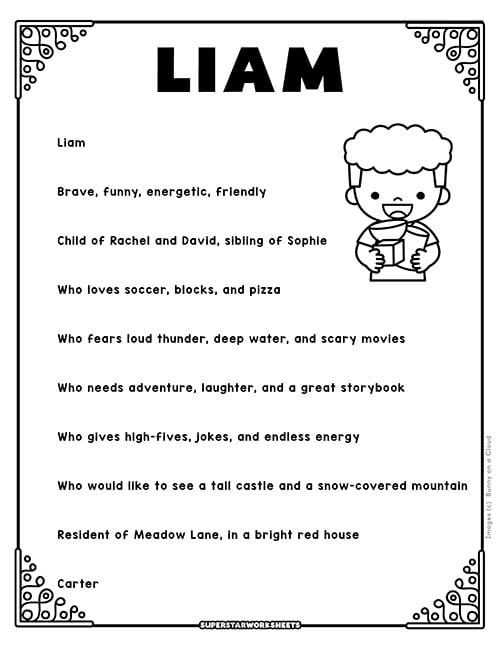
Bio Poem Activity for Kids (Boy)
This boy-themed bio poem shows students how to use the template to create a fun and interesting poem about themselves. Try “directing” this poem with your students to find rhyme, different parts of speech, and more.
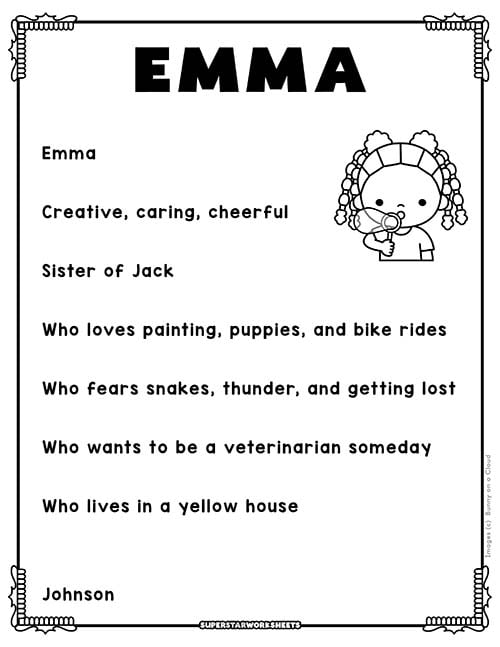
Bio Poem Activity for Kids (Girl)
Your students will love learning about each other through bio poetry! This example girl poem shows the exact steps students will take to complete the poem for themselves. This is a great activity for students to prepare for parent nights, conferences, or family gifts.
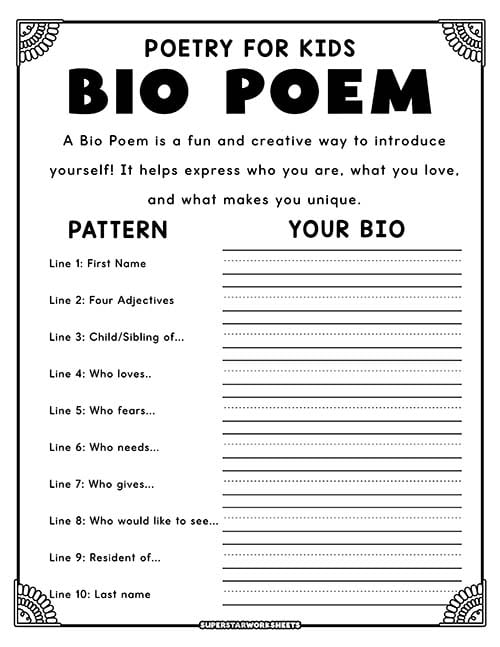
Bio Poetry Template
Start by encouraging students to brainstorm multiple options for each of their bio poem lines before selecting their final choices. This template can be modified for younger students by reducing the number of lines. Display your students’ completed bio poems alongside portraits (drawn or photographed) for a fun getting to know you bulletin board.
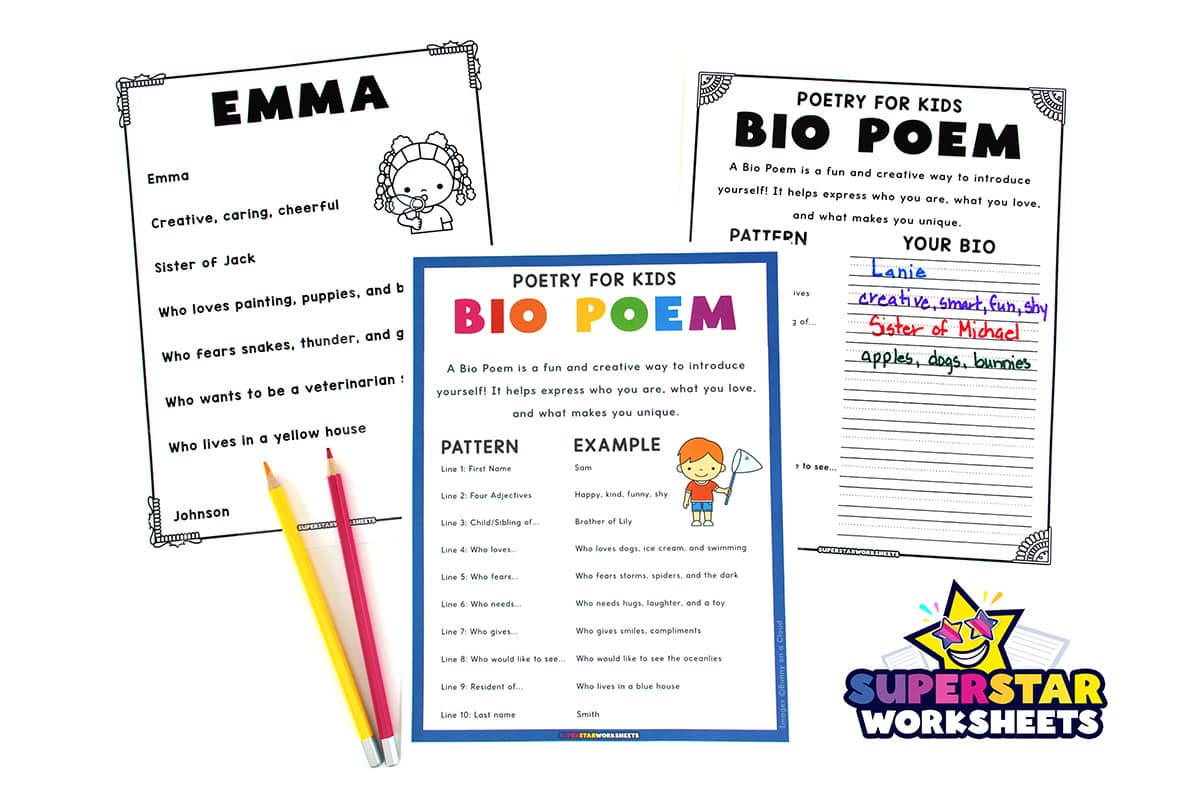
Haiku Poem
A haiku is a traditional Japanese poetry form consisting of three lines with a 5-7-5 syllable pattern. While traditional Japanese haiku focus on nature and include a seasonal reference, English-language haiku for children often maintain just the syllable pattern while exploring various topics. The Haiku’s form encourages mindfulness and close observation. Haiku helps students develop phonological awareness through syllable counting and promotes concise, image-rich language that “shows” rather than “tells.” Print charts, example poems, and templates below.
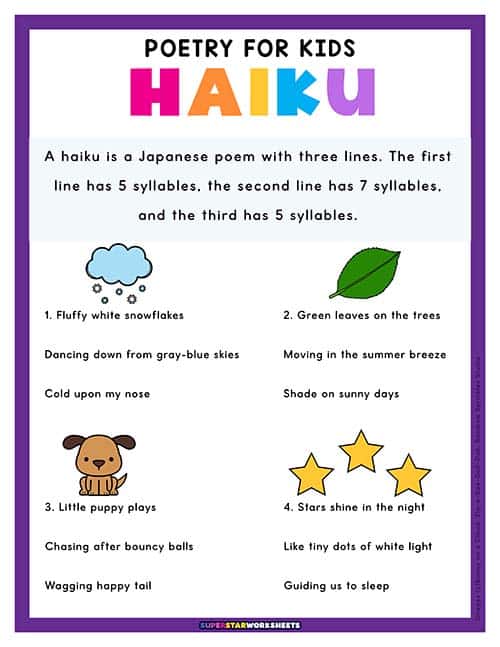
What is a Haiku Poem
This engaging chart defines a haiku along with example poems. Practice creating a syllable-counting routine using clapping, finger counting, or chin tapping to help students internalize the 5-7-5 pattern. Introduce traditional elements of haiku like nature imagery and seasonal references, but also show contemporary variations. A fun way to write could be a “Haiku Moment.” Students spend a few minutes observing something closely before writing, emphasizing the haiku tradition of capturing a specific moment or image rather than telling a complete story.
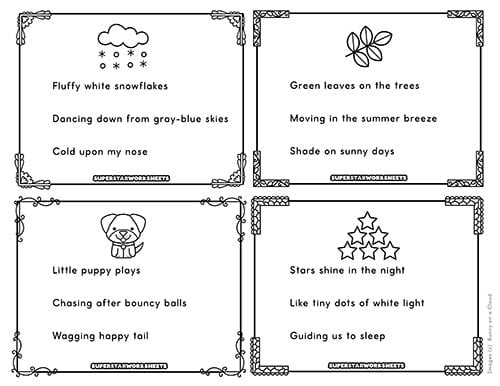
Haiku Poetry for Kids
Share both traditional Japanese haiku and contemporary examples, having students count syllables to verify the pattern. Within these example poems for kids, point out how effective haiku create vivid images with minimal words and often include a surprising element or shift in perspective in the final line.
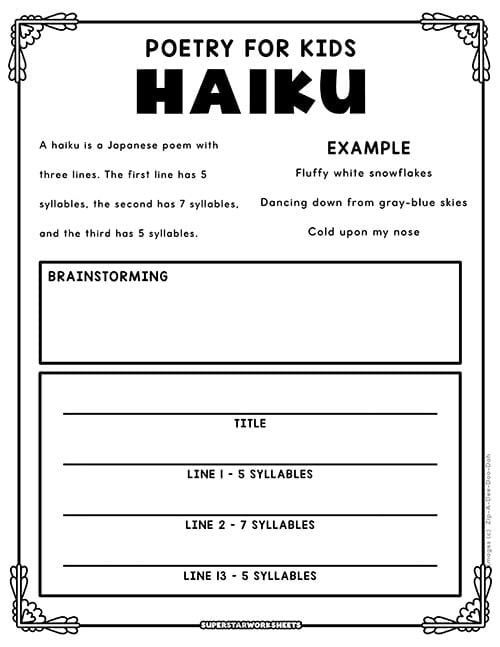
Haiku Poem Template
It’s important to brainstorm before writing. This haiku template gives students a place to brainstorm or use these graphic organizers. When using this template, discuss the syllable-counting lines to help students maintain the 5-7-5 structure. Once students have the formula down, they can create thematic haiku collections or compile a haiku journal with weekly entries that observe changing seasons or document learning experiences.
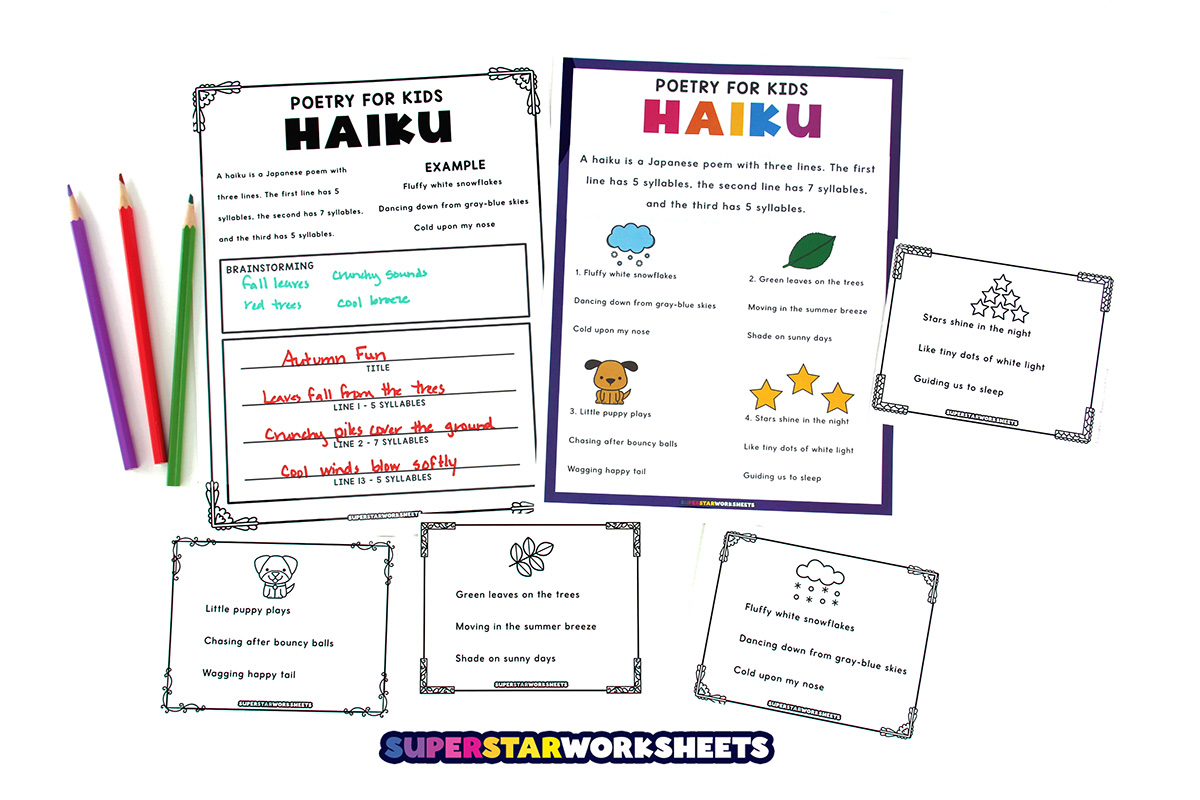
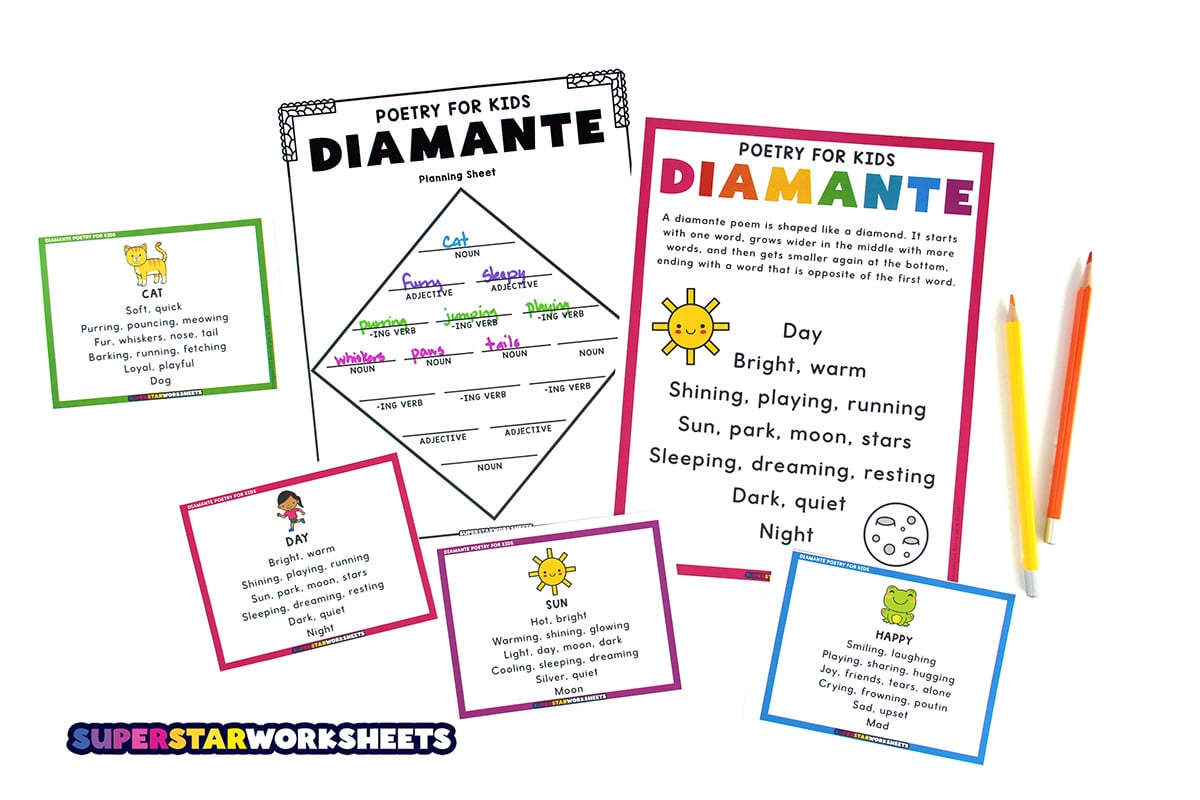
Diamante Poem
Teach your children how to write diamante poems with these poetry guides, examples, and templates. A diamante is a diamond-shaped poem with seven lines that follows a specific part-of-speech pattern. The poem begins with a single noun, expands to describe and explore that noun or its opposite, and then narrows to end with a contrasting noun, creating a visual and conceptual “diamond” that either compares related concepts or contrasts opposites. This structured poetry helps students develop vocabulary, practice parts of speech, and explore relationships between concepts.
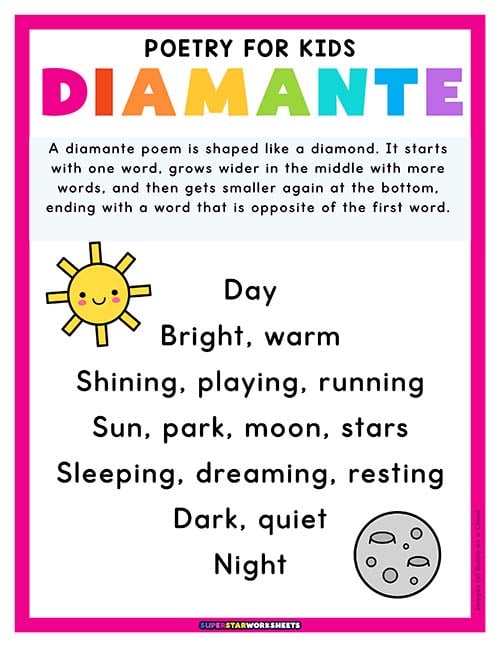
What is a Diamante Poem
This diamante poetry poster is a visual diagram showing the diamond shape created by each line. Discuss parts of speech with students to help them understand the pattern. An easy activity would be to create a class parts-of-speech word wall specific to diamante writing, with columns for nouns, adjectives, and participles related to common topics.
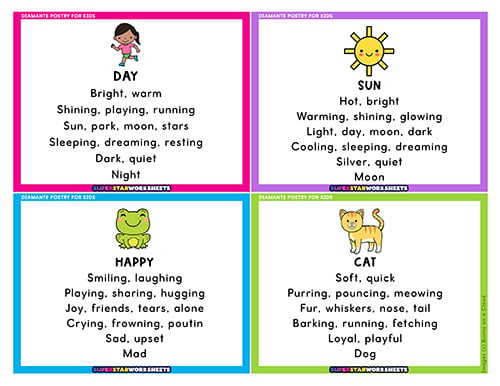
Diamante Poetry for Kids
This full page of diamante poems for kids helps students in elementary school visualize the diamond shape. For differentiation of diamante poetry, offer word banks organized by parts of speech for struggling writers. Create a diamante poetry book about student learning as an end of unit/year assessment. Students can create diamante collections exploring concept pairs within a single topic area.
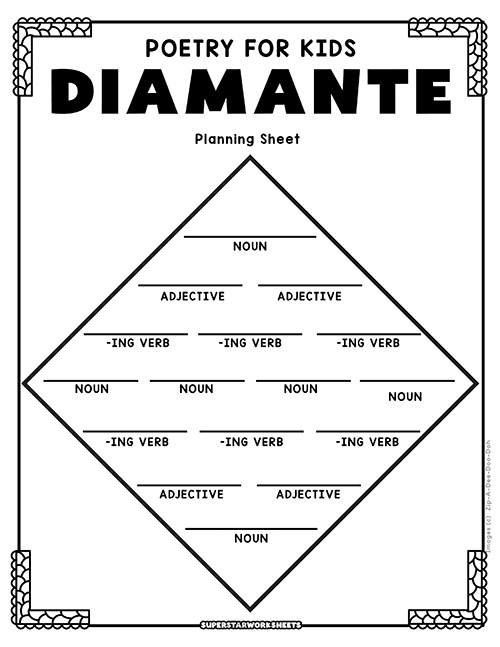
Diamante Poem Template
These diamante templates provide sentence frames shaped like diamonds with spaces to fill in appropriate parts of speech. Be sure to review different parts of speech before writing diamante poetry. For struggling writers, offer word banks organized by parts of speech.
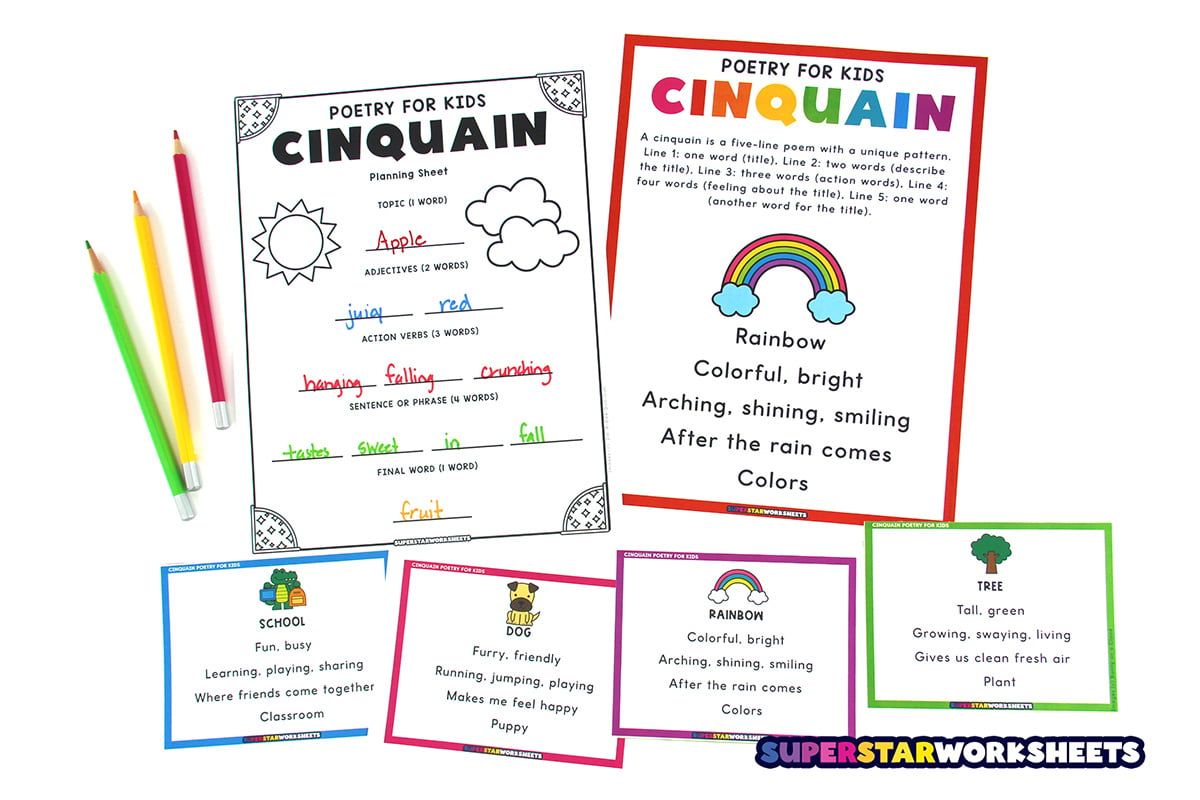
Cinquain Poem
A cinquain is a five-line poem with a specific syllable pattern or word count per line. The most common form for children is the Didactic Cinquain, which follows a 2-4-6-8-2 syllable pattern or a 1-2-3-4-1 word count pattern. Cinquain poetry form helps students practice counting syllables or words while focusing on descriptive language. Cinquains typically center on a single subject, with each line building more detail about that subject—starting with a noun, adding descriptive words, then actions, feelings or a phrase about the subject, and finally a synonym or summary word.
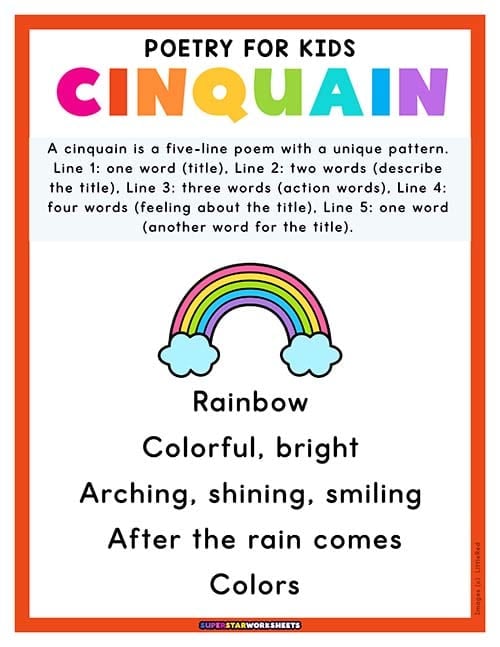
What is a Cinquain Poem
When teaching cinquains, use hand clapping or finger counting to help students count syllables accurately. This visual anchor chart shows the pattern with an example poem. Feel free to color code and/or label it for easy reference. Try using mini-whiteboards where students can draft and revise lines before committing to their final cinquain.
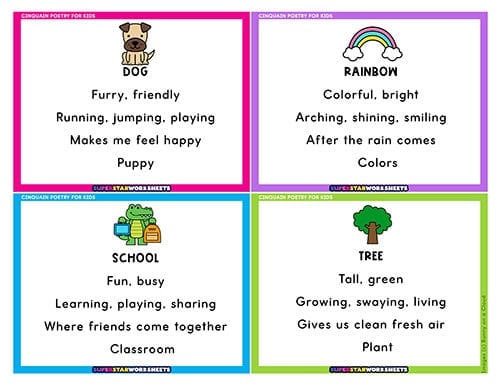
Cinquain Poetry for Kids
Share these examples of cinquains about dogs, school, rainbows, and trees. When reviewing these poems, have students identify and count the syllables or words in each line to verify the pattern. Point out how effective cinquains use precise nouns and vivid verbs rather than generic ones.
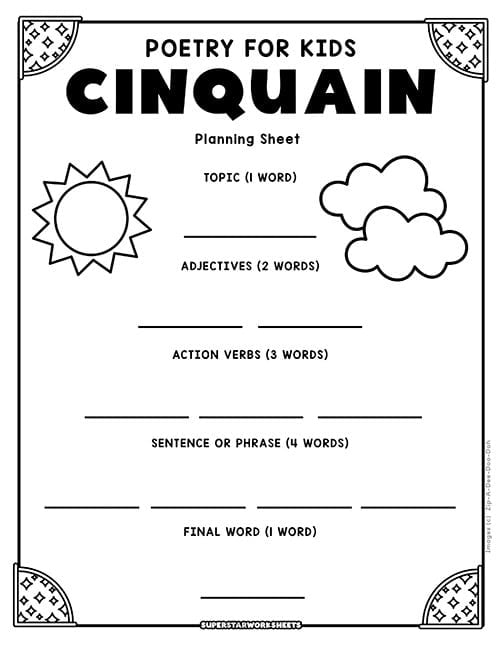
Cinquain Poem Template
Students can create cinquain collections using this poetry for kids cinquain planning sheet. When using this template, provide subject suggestions aligned with curriculum topics or student interests. Display completed cinquains on a “Cinquain Symphony” wall where poems are organized by topics or themes.
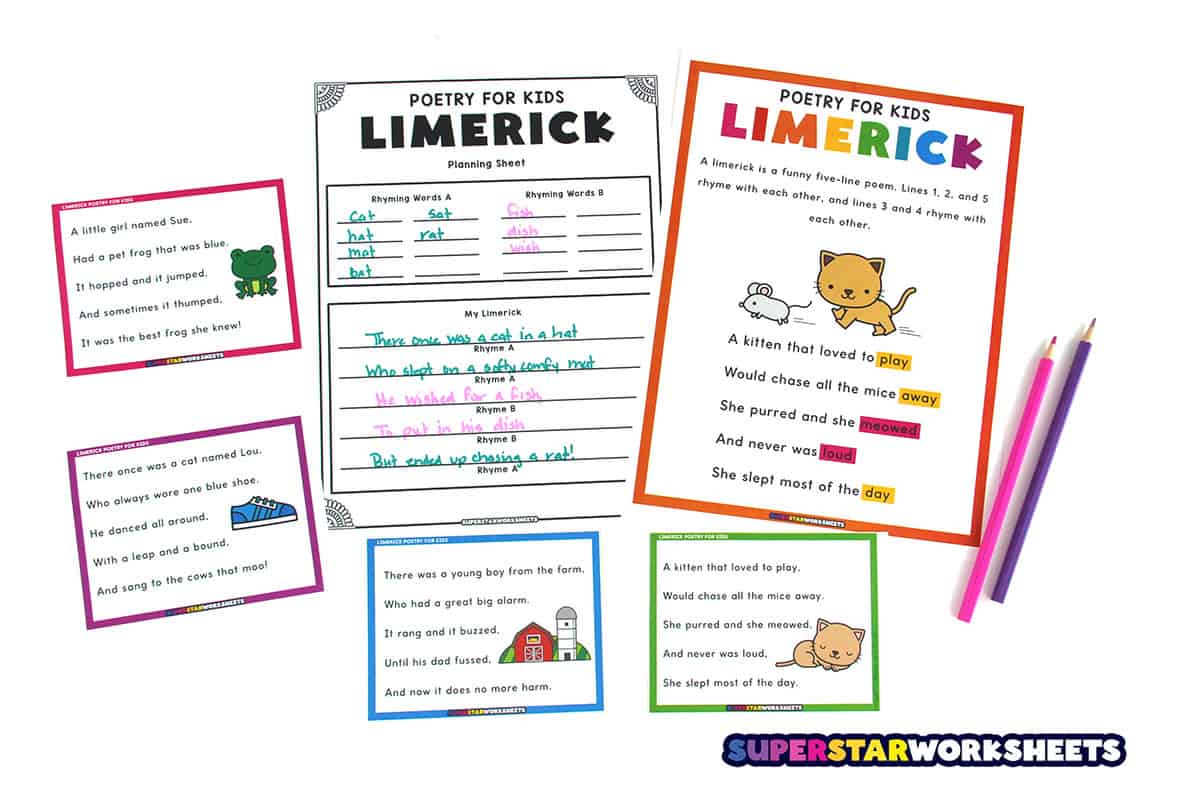
Limerick Poem
Limerick poetry consists of a five-line, rhythmic poem with an AABBA rhyme scheme that typically tells a brief, humorous story about a character. This playful poetry form follows a specific structure: the first, second, and fifth lines have 7-10 syllables and share the same end rhyme (A), while the third and fourth lines are shorter (5-7 syllables) and share a different end rhyme (B). The distinctive rhythm of limericks creates the characteristic “musical” quality that makes limericks so fun to read aloud – think Dr. Seuss. They’re excellent for developing phonological awareness through rhyme. Download and print our limerick poem guides, poetry examples, and templates below.

What is a Limerick Poem
This limerick poem chart is a color-coded visual showing the AABBA rhyme scheme to help students internalize the rhythmic pattern (LOUD-soft-soft-LOUD-soft-soft-LOUD). Read this example aloud with exaggerated rhythm, encouraging students to “feel” the characteristic bounce. An easy way to start is with fill-in-the-blank limericks, where students only need to supply the rhyming words before attempting full compositions.
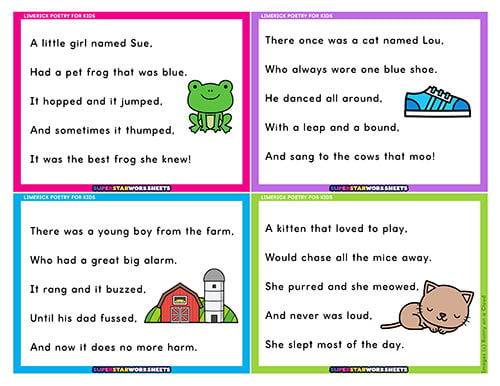
Limerick Poetry for Kids
Explore these elementary age-appropriate limericks by having students identify the rhyming words and clap along to the rhythm. Discuss how effective limericks often include humor, exaggeration, or a surprising twist.

Limerick Poem Template
This limerick template provides rhythmic guidelines for students. Offer rhyming word banks organized by common limerick end sounds that students can choose from. Display completed limericks on a poetry bulletin board with student illustrations. Check out more rhyming worksheets here.

Quatrain Poem
Free printable quatrain poem examples, writing templates, and anchor charts you can use to teach your children how to write quatrain poems. A quatrain is a four-line stanza that serves as the building block for many poetry forms. While quatrains can follow various rhyme schemes—including AABB (pairs), ABAB (alternate), ABBA (enclosed), or AAAA (mono-rhyme)—they are defined by their four-line structure rather than by a specific rhyme pattern. This flexibility makes quatrains adaptable for writers of all abilities. Download and print our quatrain poem guides, poetry examples, and templates below.
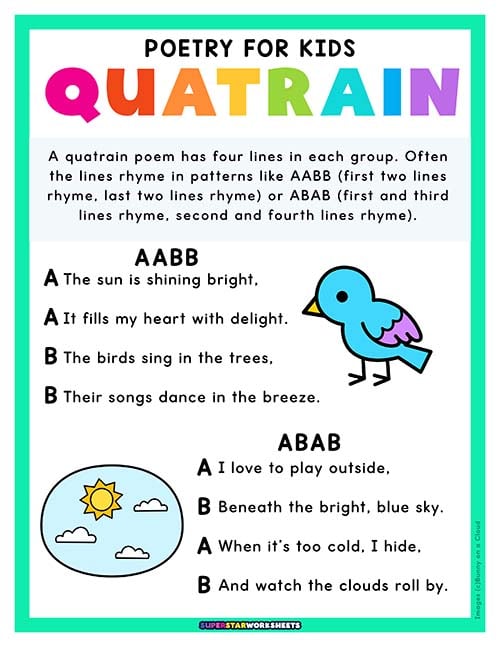
What is a Quatrain Poem
This free printable visual chart shows different rhyme pattern options (AABB, ABAB) with examples. Model how to plan a quatrain by first deciding on a topic, then the rhyme scheme, and finally drafting the lines to fit the pattern. Demonstrate how different rhyme schemes create different effects—AABB often feels bouncy and straightforward, while ABAB creates a more musical interwoven effect.
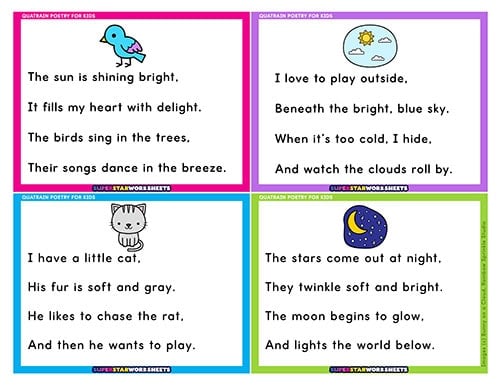
Quatrain Poetry for Kids
This printable quatrain example page gives students examples to use when getting started with their writing. You could also share diverse quatrain examples from poetry and song lyrics, having students identify the rhyme schemes and discuss how they contribute to the mood.
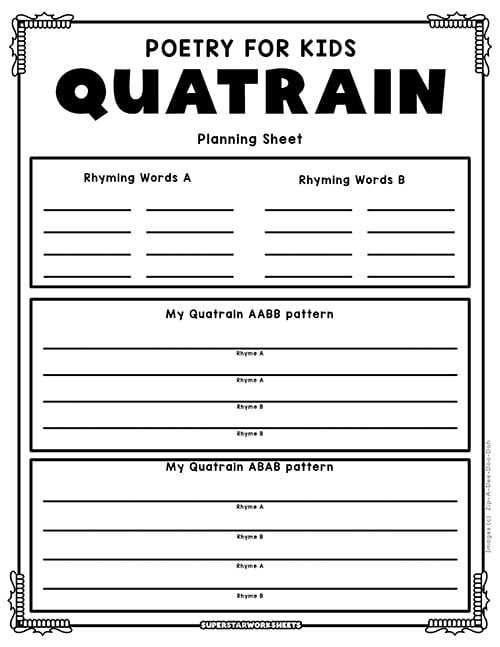
Quatrain Poem Template
Teachers using quatrain templates could have students make curriculum connections. Suggest quatrain topics related to current units of study. Display completed quatrains on a “Pattern Poetry” wall organized by rhyme scheme. Students can compile a “Quatrain Through the Year” anthology with seasonal or monthly entries.

Riddle Poem
Riddle poems are playful verses that describe something without naming it directly, challenging the reader to guess the subject. Unlike some poetry forms that follow strict structural rules, riddle poems are defined by their purpose (to puzzle the reader). They can be as short poems for kids as two lines or extend to several stanzas, and may or may not rhyme. What makes them distinctive is their use of metaphor, sensory details, and clever wordplay to hint at—but not reveal—their subject. Riddle poems engage critical thinking as readers analyze clues and draw connections, while writers must consider their subject from unusual perspectives to create effective hints.
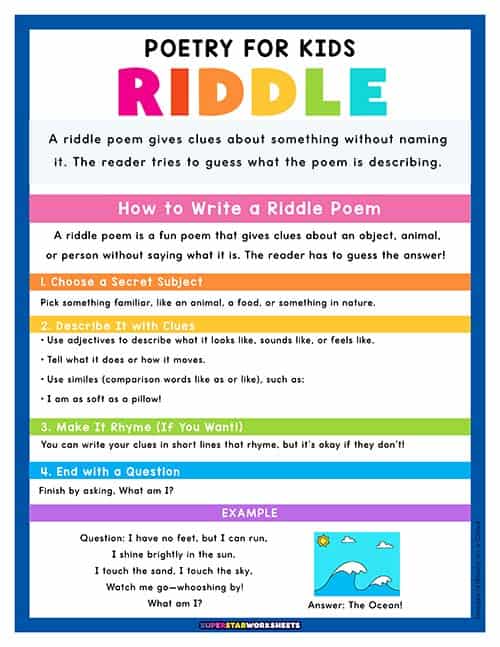
What is a Riddle Poem
This is our printable “Riddle Strategy” anchor chart. It lists the exact formula to create a riddle poem. Choose a secret subject, describe it with clues, make it rhyme (if you want), and finally end with a question. This poster makes a great visual for students in classrooms or homeschool settings or as reference pages in a writing folder.
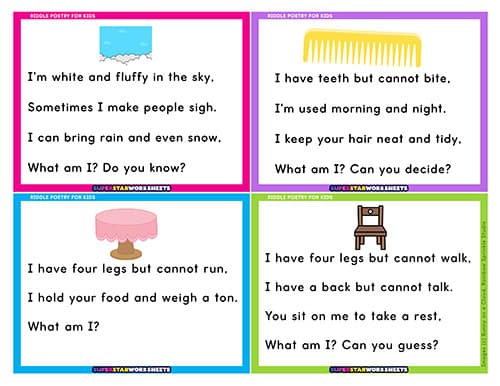
Riddle Poetry for Kids
Start your riddle poetry unit by reading these examples to your students. Help students identify which clues were most helpful in solving them and which were misleading. Point out how effective riddles often personify their subjects, using first-person perspective to bring objects to life.

Riddles Poem Template
This is basically a DIY funny poem for kids. Provide sensory-focused prompts to help students generate clues: “What does it look/sound/feel/smell/taste like?” and “What does it do or how is it used?” For younger students, offer picture-supported templates where they can check off attributes from options before crafting them into clues.
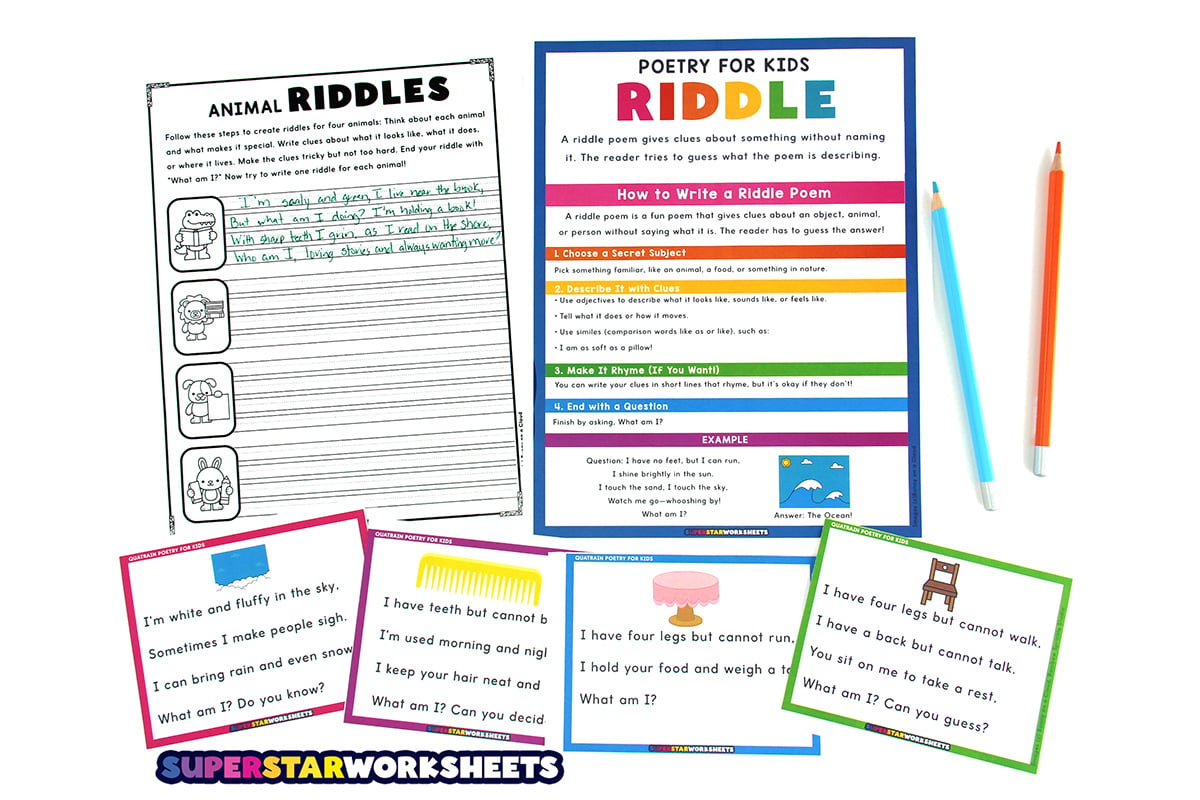
Color Poem
Color poetry focuses on a single color and uses sensory imagery to explore associations, emotions, objects, and experiences related to that color. Unlike some poetry forms with strict structural rules, color poems are flexible in their format—they can be free verse or follow a rhyme scheme, be short or long. Color poems are poems with metaphor for kids, connecting abstract concepts like emotions to concrete sensory experiences. They’re excellent for developing vocabulary, especially adjectives and sensory words, while encouraging students to make personal connections to colors beyond their visual qualities.
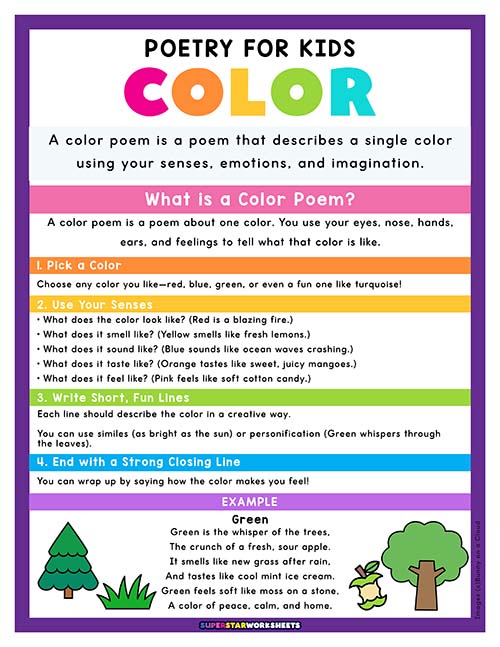
What is a Color Poem
This poster is a step-by-step formula to create a color poem. When introducing color poems, create a multi-sensory experience by having students explore objects of the target color—touching fabrics, smelling scents, listening to sounds, and tasting foods associated with it. Create a five-senses chart for the color, gathering class ideas for what the color might smell, taste, sound, feel, and look like. Encourage students to think about emotions, memories, and metaphors connected to the color.
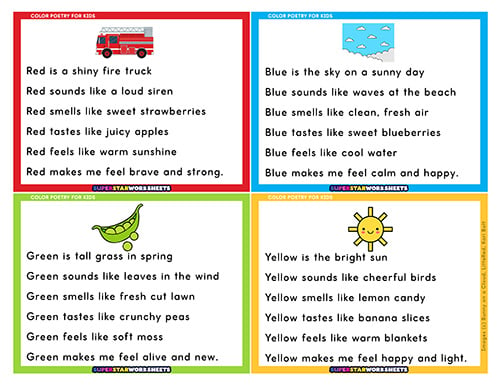
Color Poetry Examples for Kids
Share these color poem examples with your students and have them identify the sensory details and emotional connections. Give them an opportunity to discuss how effective color poems go beyond simply listing objects of that color and instead create vivid imagery.
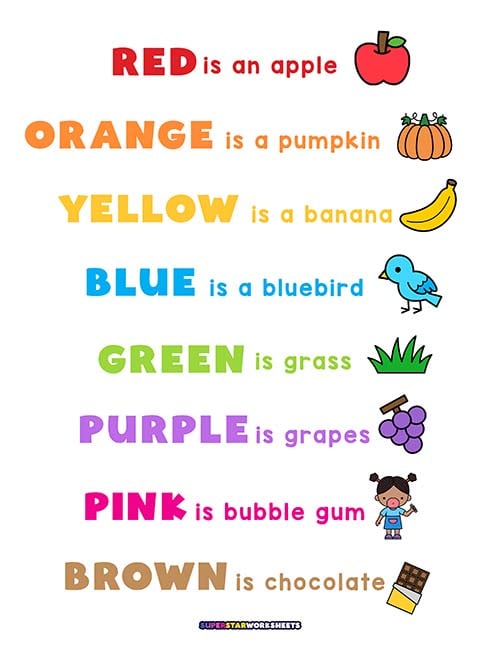
Color Poem Template
When students use color poem templates, encourage them to first create a mind map of their chosen color, branching out into categories like “objects,” “feelings,” “places,” “memories,” and “seasons.” For primary grades, try simple “Color is…” repeated line formats; for intermediate grades, introduce “I am the color…” templates where students write from the perspective of the color itself.
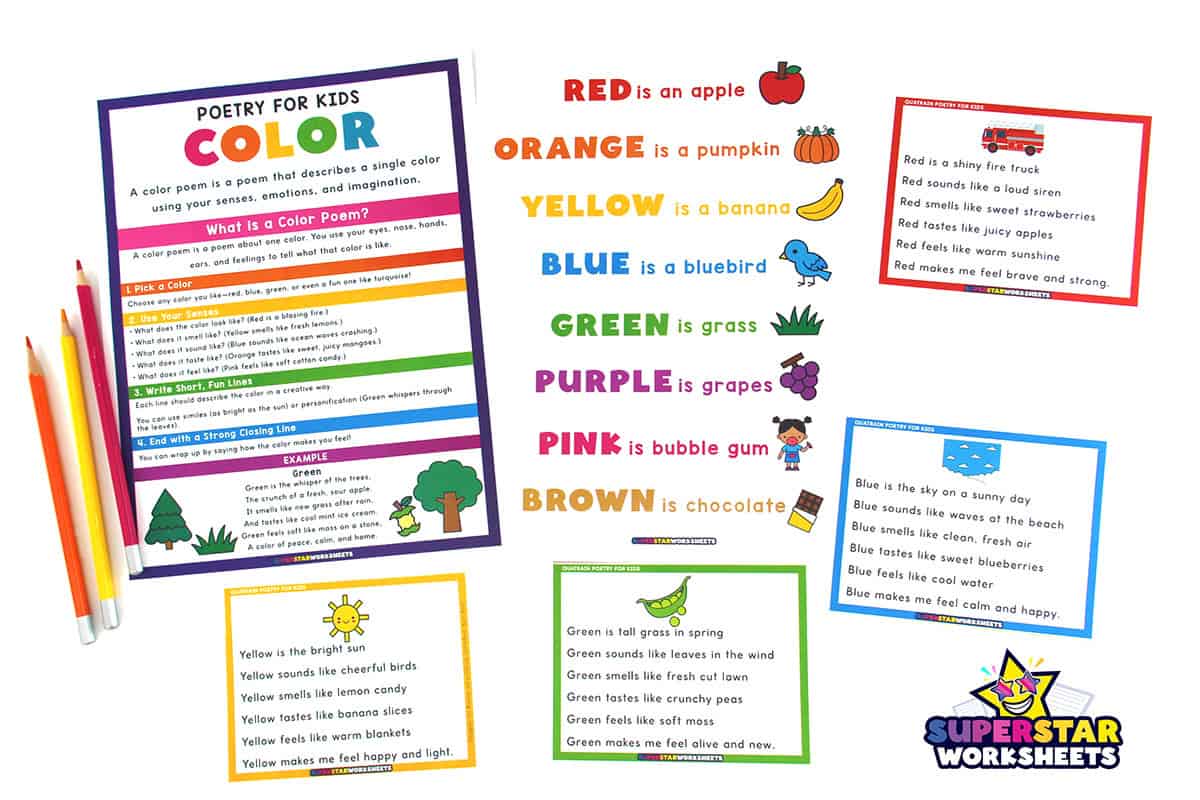

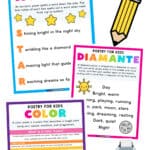
Comment (1)
These are some of the best poetry worksheets I’ve seen for kids.
THANK YOU!